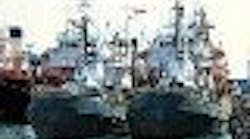ONCE UPON A TIME, I would have qualified for the A Ship. Today, I don’t know where I belong. I wonder if you know. The story of the A Ship and the B Ship comes from The Restaurant at the End of the Universe, published in 1980 by Douglas Adams. It was the sequel to Adams’ The Hitchhiker’s Guide to the Galaxy.
As the story goes, a race of people from a doomed planet were aboard a giant space Ship, fleeing a sun that was going to explode. Scientists said the entire population had to flee, so they built three giant space Ships. “The idea was that into the first Ship, the ‘A Ship,’ would go all the brilliant leaders, the scientists, the great artists, you know, all the achievers,” says the captain of the B Ship. “And then into the third, or ‘C Ship,’ would go all the people who did the actual work, who made things and did things; and then into ‘B’ Ship–that’s us–would go everyone else, the middlemen, you see.”
The B Ship held politicians, accountants, advertising agency people, high-level company managers, non-bankruptcy lawyers, and–this is very important–the people who sterilize telephones. All the useless people of society, in other words.
“You’re a load of useless bloody loonies!” says our hero, Ford Prefect, one of the hitchhikers. “Ah, yes, that was it,” beamed the captain.
The sun did not explode, so the home planet never built or launched the A and C Ships. When the B Ship landed at its destination planet, the people were incapable of feeding themselves or building shelters. They were, however, able to hold meetings, issue statements, and write position papers. They all died.
Alas, the people on the home planet also died, from a disease spread by unsterilized telephones.
If that happened here, what Ship would you be on? I like to think that, back in the days when I worked for NASA and later, when I programmed process control computers, I would have qualified for the A Ship or, at least, the C Ship. That was real work, and I look back in pride.
Once in my life, when I worked for an industrial public relations agency, I was definitely on the B Ship. Now, I don’t know. Does a cynical, vendor-baiting writer like me qualify for the A or C Ships? Or am I useless, too?
And what about you? When you started your career in process control, you probably had hands-on responsibility for setting up control systems, designing and installing instrumentation, and you solved problems. You made real stuff, prevented deadly accidents, and were responsible for millions of dollars worth of control and process equipment. You were an A Ship passenger.
But your job is changing. Today, design and configuration is done by consulting engineers and process control vendors. Maintenance is contracted out. You watch your colleagues leave and not get replaced. If you are still employed in a process plant, you may be one of the only control engineers left on staff.
Most likely, you are becoming more of a B-Ship paper-pusher than an engineer. You approve invoices and plans from subcontractors that are doing work you wish you could be doing. You oversee people who know less than you do about the process and control technology.
I fear for the future of our profession. I fear that process control will become just another “service” that your accountant-managers will outsource to the lowest bidder from a Third-World country. I fear that we will all become B Ship passengers.
What can we do about it? For one, we can push ISA, IEEE and the other societies to lobby Congress to make control engineering a certified profession. There are laws on the books in some states that call for professional engineers to do certain kinds of work, such as civil engineering, nuclear engineering, and even boiler maintenance and repair. Why not control and instrumentation?
The recent explosion in Texas is just the latest in a series of process plant mishaps dating back to Bhopal. If certified instrumentation and control engineers had been in charge of the design, installation, operation and maintenance of those plants, the mishaps might not have occurred.
Whenever manufacturing plants deal with hazardous chemicals and dangerous processes that can affect the surrounding community and the plant’s workers, certified control engineers should be in charge. Maybe that will guarantee us a place on the A Ship once again.
By Rich Merritt, Senior Technical Editor




